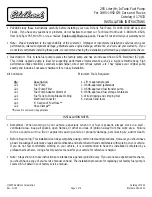
How does the Safety Canopy
姟
system work?
The design and development of the
Safety Canopy
娂
system included
recommended testing procedures
that were developed by a group of
automotive safety experts known as
the Side Air Bag Technical Working
Group. These recommended testing
procedures help reduce the risk of
injuries related to the deployment of
side airbags (including the Safety
Canopy
娂
).
The Safety Canopy
娂
system
consists of the following:
•
An inflatable nylon curtain with a
gas generator concealed behind
the headliner and above the doors
(one on each side of vehicle).
•
A headliner designed to flex open
above the side doors to allow Safety Canopy
娂
deployment.
•
The same warning light, electronic control and diagnostic unit as used
for the front airbags.
•
Two crash sensors mounted in the b-pillars (one on each side).
•
Two crash sensors located at the c-pillar (one on each side).
•
Rollover sensor in the restraints control module (RCM).
The Safety Canopy
娂
system, in combination with seat belts, can help
reduce the risk of severe injuries in the event of a significant side impact
collision or rollover event.
Children 12 years old and under should always be properly restrained in
the second or third row seats. The Safety Canopy
娂
will not interfere
with children restrained using a properly installed child or booster seat
because it is designed to inflate downward from the headliner above the
doors along the side window opening.
The Safety Canopy
娂
system is designed to activate when the vehicle
sustains lateral deceleration sufficient to cause the side crash sensor to
close an electrical circuit that initiates Safety Canopy
娂
inflation or when
a certain likelihood of a rollover event is detected by the rollover sensor.
The Safety Canopy
娂
is mounted to roof side-rail sheet metal, behind the
headliner, above the first and second row seats. In certain lateral
2003 P207 Explorer Sport Trac
(p27)
Owners Guide (post-2002-fmt)
USA English
(fus)
Seating and Safety Restraints
92
















































